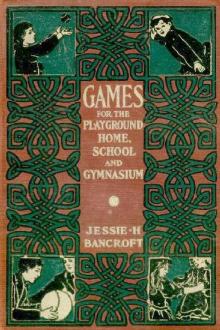Games for the Playground, Home, School and Gymnasium by Jessie Hubbell Bancroft (top novels of all time .txt) 📕

- Author: Jessie Hubbell Bancroft
- Performer: -
Book online «Games for the Playground, Home, School and Gymnasium by Jessie Hubbell Bancroft (top novels of all time .txt) 📕». Author Jessie Hubbell Bancroft
The first players in the rows rise from their seats on a given signal, toe the line at the head of their aisle, and catch the ball, which should be tossed to them immediately by the leader who stands opposite. This player quickly returns the ball to the leader by means of another toss, and sits down at once. His sitting is a signal for the player next behind him to run forward to the line, catch the ball from the leader, toss it back to the leader, and reseat himself. This continues until every player in the line has caught and returned the ball, when the leader should return to his seat and hold the ball up at arm's length, as a signal that his line has finished. The line wins whose leader is the first to do this.
For a more advanced form of this game, see Home Run.
LINE CLUB BOWLS (DOUBLE)2 to 60 or more players.
Playground; gymnasium; schoolroom.
Hand ball; bean bag; Indian clubs.
This game is like Single Club Bowls, except that the object of the play is to pass the ball or bean bag between a pair of upright Indian clubs, instead of trying to knock one over.
If there be a few players, one pair of clubs is set up for each player, with an interval between them two inches wider than the diameter of the ball that is used. At from ten to twenty feet from the clubs a line is drawn on which the players stand to throw. The players slide the bag over the floor or roll the ball; all play at once, each player scoring one if his ball or bag goes between the clubs without knocking them over. The clubs are then put in order if displaced, the balls or bags gathered up, and the players return to the starting line and bowl again.
The player wins who first scores twenty-five or fifty, as may be determined before the game opens.
Where there is a large number of players, the same form of play is used with the players in relay formation; that is, they should be divided into groups of equal numbers, each group lining up in single file before the starting line, and each member of the group bowling in turn.
The group or team with the highest score when all have bowled wins.
LINE CLUB BOWLS (SINGLE)2 to 60 or more players.
Playground; gymnasium; schoolroom.
Basket ball; hand ball; bean bag; Indian club.
This game differs from Double Club Bowls only in the object of the play. In Single Club Bowls the object is to knock over one Indian club which stands alone. In Double Club Bowls the object is to bowl the ball or bean bag between two upright Indian clubs without knocking them over.
Any kind of ball or bean bag may be used for this game. If there be few players, one Indian club is set up for each player, all clubs being widely separated and on a given line. At from ten to thirty feet from this club line a second line is drawn, on which the players must stand to play. The players all slide the bag over the floor or roll the ball, at once, each player scoring one when he knocks over his Indian club. The clubs are then replaced, the balls or bags gathered up, and the players return to the starting line and bowl again.
The player wins who first scores twenty-five or fifty, as may be determined before the game opens.
Where there is a large number of players, the same form of play is used with the players in relay formation; that is, they should be divided into groups of equal numbers, each group lining up in single file before the starting line, and each member of a group bowling in turn for the club. After each player has bowled, he should replace the club and bring back the ball or bean bag to the next player. In this form of the play it is not necessary for the different rows to throw simultaneously, unless that be desired as a question of order or to facilitate the scoring. The row or team which makes the highest score wins.
LINE ZIGZAG10 to 100 players.
Playground; gymnasium.
Basket ball; hand ball.
This is a game of ball played by half of the players while mounted on the backs of the other players. It is therefore desirable that the players be paired off so that the two in each pair should be of nearly equal weight and size.
The players form a circle in pairs. To do this they line up two abreast, each with his selected partner. This double line then marches in circle, halts, and faces inward. This will form two concentric circles. There should be considerable space between couples; in other words, the circle should be rather large in comparison with the number of players. It is then decided by a toss-up or otherwise which of the two circles shall first be "ponies" and which shall be riders. The ponies bend forward from the hips, pressing their hands against the knees, or thighs just above the knees. The knees should be stiff, not bent. The backs are thus bent forward and the riders mount, straddling the shoulders of the players who are ponies.
The ball is put in play by being tossed from any player to another, and the game consists on the part of the riders in trying to keep the ball in as active play as possible in a simple game of toss and catch, and on the part of the ponies in trying to prevent the catching of the ball. To do this the ponies must grow restive and turn around in any way they see fit, but must not lose their general places in the circle.
When a rider fails to catch a ball, all of the riders must at once dismount and run in any direction; the pony belonging to the rider who missed the ball picks up the ball immediately, and as soon as he has it calls "Halt!" All of the riders must then stand still, and the player who holds the ball tries to hit his recent rider. The rider aimed at may try to evade the ball by stooping or jumping, but must not otherwise leave his place on the floor. During this part of the play the other ponies remain in their position in the circle, so that the one who is throwing the ball will not confuse them with the riders. If the player (pony) who throws the ball at his dismounted rider succeeds in hitting him, all of the ponies and riders exchange places, the riders becoming ponies and the former ponies mounting them. If the player aiming the ball at his dismounted rider does not succeed in hitting him, the riders remount and the game goes on as before.
It is not permissible for a rider to hold a ball at any time, no matter how difficult his position at the moment may be; he must toss it at once. It is well to have a leader, whether one of the players or not, who watches for mistakes, gives the commands to mount and dismount, and announces misses and hits.
This game was played by the ancient Greeks, and is found in various forms in many countries. It is needless to say that it is one of the more strenuous games. When properly played it contains great sport.
NINE-COURT BASKET BALL18 to 60 players.
Playground; gymnasium.
Basket ball.
This is one of the comparatively few games that gives a large amount of activity to a large number of players playing at the same time. The game as here given is the invention of Miss Cora B. Clark and Miss Caroline M. Wollaston of New York City, by whose kind permission the game is here printed. It has proven to be a most popular and interesting game.
GROUND.—The playground or court should measure about forty by forty feet in outside dimensions, the basket ball goals being placed at the usual height (ten feet) on opposite sides of the court. One basket belongs to each team. For instance, the teams are designated as Red and Blue; one basket belongs to the Red team and the other to the Blue team. The ground is then further divided into nine even squares. This may be done in any of the usual lining methods as described on page 301. The small squares are numbered in consecutive order around the outside, starting in one corner; the ninth one is in the center. When players are learning the game it may be advisable to mark these numbers on the ground, but for players familiar with the game this may be dispensed with.
TEAMS.—While from eighteen to sixty players may play this game at once, eighteen makes the best playing number. Where there is a larger number it may be found best to divide them into two sets, each set to play for ten minutes and then give place to the other, and so on alternately.
The players are divided into two teams, each with a captain. The teams are chosen by the following method:
The players are lined up according to height and either by marching (one to the right and one to the left) or by numbering off (the even numbers stepping out of the line) are divided into two files standing side by side. Each file constitutes a team, and each member of a team is paired off with the opponent standing in the file beside him. By this method the two opponents forming a couple are of practically equal height.
The couples are numbered as they pair off, the number indicating to which court they shall go for the opening of the game. Thus, couple Number One will go to the small court marked 1, couple Number Two to the court marked 2, etc. Should there be more than nine couples, the tenth couple will go to court number 1, the next couple to court number 2, etc. Usually only one or two couples go to each small court, but sometimes three or four couples must be so assigned, to accommodate a large number of players. Where there are so many, however, it will be found best to divide the number into halves, one half playing at a time, as previously mentioned. Should there be an odd player (without a partner), he is placed in the center court (number nine), and remains there throughout the game. A good leader, however, will see that some player changes off with this odd individual during the game.
It will thus be seen that each court contains an equal number of players of each team. For instance, if there be but two players in a court, one of them belongs to the Red team and the other to the Blue team. If there be four players in the court, two of these belong to the Red team and two to the Blue team, etc.
OBJECTS OF THE GAME.—The objects of the game for each team are, (1) to throw the ball into its own





Comments (0)